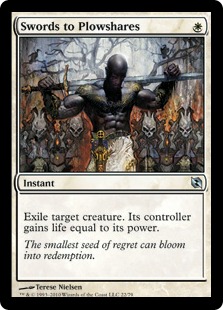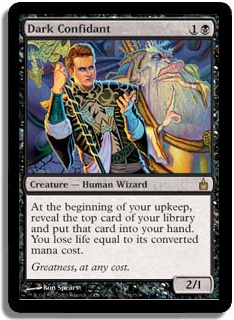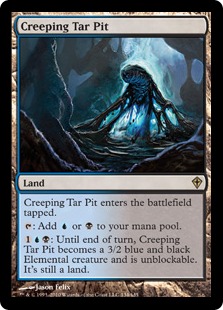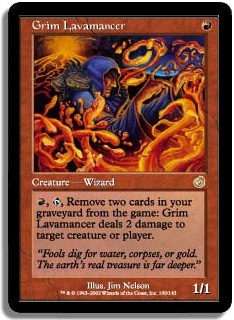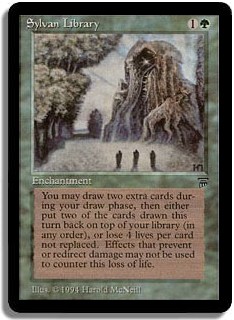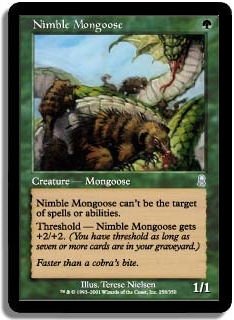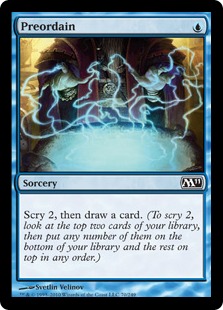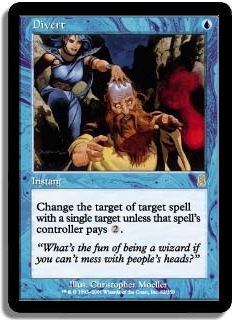This past week was pretty hectic, what with Thanksgiving and all. Kali and I decided to take a trip home to see all our friends and family, which will be repeated for Christmas, and it was an amazing week. We had a blast, and it was really great to catch up with the people we love and hadn’t seen much in quite a while. The move from Alabama to Virginia was a bit hard on us at first, but the fact that I was getting homesick for Roanoke makes me feel like I’ve adjusted well.
With that said, I bet you can guess how little time I had to actually play Magic. With turkey comas and karaoke nights abounding, we didn’t even really bother turning on the laptop, let alone firing up Magic Online. But on the long drives to and from my old homeland, I was able to do a lot of brainstorming—mostly about Legacy. Shall we begin?
For starters, I’m sure a few of you read my article a few weeks ago that included a section about RUG Delver (or Canadian Threshold or RUG Tempo, if you will). This deck has been dominating the StarCityGames.com Legacy Opens, and with good reason. It is a solid piece of work with a lot of cool tricks and utility spells surrounding a powerful, disruptive core.
Before we break anything down, here is the stock list for RUG Delver:
Creatures (12)
Lands (18)
Spells (30)
- 4 Brainstorm
- 4 Lightning Bolt
- 4 Force of Will
- 3 Daze
- 4 Stifle
- 1 Temporal Spring
- 1 Life from the Loam
- 3 Spell Snare
- 4 Ponder
- 2 Dismember
Sideboard

This list brought Jonathan Job victory in Las Vegas, and it is easy to see why. You have a lot of disruption as well as some of the best creatures in Magic at your disposal. Toss in some Lightning Bolts, and you’ve got yourself a winner, right? Well, let’s take a closer look.
For starters, every single pilot has advocated cutting Temporal Spring. While cute, it was not good. What I find hilarious is that Lewis Laskin was the first person to play it back at SCG Baltimore, and he said he sided it out in almost every single match. Then, in Kansas City, David Thomas took down the crown with a similar list, but still didn’t cut the Temporal Spring. In his post-match interview, he stated that he basically mulliganed every time he drew it.
What vexes me the most is that both finalists at the event in Las Vegas played the exact same seventy-five as David Thomas, down to the Temporal Spring, and then Jonathan Job goes on to say that he wish he had never played Temporal Spring in the first place. Are we getting the picture? Do I really need to say this?
Don’t play Temporal Spring!
All right, enough about that card. I really never thought I would have to say that in a public forum, but crazier things have happened. After all, Vapor Snag is a good card in Standard—who would have thought? I’m not going to explain in fine detail just how awful Temporal Spring really is, but non-creature spells that cost more than two mana should come damn close to winning you the game. Otherwise, you probably shouldn’t bother.
Now that we’re over that tangent, let’s examine exactly what makes this deck tick, and how we can use it to create something better.
At its heart, this “tempo” deck is nothing new. It got a few shiny new toys to play with, but versions using Nimble Mongoose have been around for quite a while now. What makes this deck so interesting, to me at least, is that the red and green cards are effectively a splash. The core of the deck is incredibly powerful:
4 Ponder
4 Stifle
3 Daze
As you can see, this looks like the beginning of a really strong mono-blue deck. The “splashes” in the deck include all-time favorites like Lightning Bolt and Tarmogoyf. Both colors offer interesting sideboard options, but every color has at least a few interesting ones. My point is this:
Why can’t you play other colors instead of red and green? I can understand the allure of Tarmogoyf, as well as the potentially swingy nature of Lightning Bolt with Snapcaster Mage, but I’m honestly shocked that we can’t find something better. With the oblivious, follow-the-leader attitudes that currently overwhelm much of the player base, it is no wonder that this deck hasn’t had any sort of revamp in weeks.
Let’s talk about some of the easier splashes we could make in each of the surrounding colors, and what they could potentially add to the deck.
White
For one, I am a huge fan of adding white to the deck, but I feel like it would be taking the deck in a new direction. Swords to Plowshares, while a fine removal spell, is not great at helping you race. Thanks to Snapcaster Mage, Lightning Bolt as the removal-of-choice is quite solid for a lot of reasons, but that is mostly due to its ability to go to the dome. Swords to Plowshares will always be a dead card against creatureless combo decks, but Lightning Bolt can provide some racing potential. However, Lightning Bolt doesn’t always kill Tarmogoyf or Knight of the Reliquary, which can occasionally be a huge problem. Swords to Plowshares gives you that added bit of protection, which is really nice.
Path to Exile
Outside of Swords to Plowshares, you could opt for the Path to Exile plan. While a little more dangerous due to giving your opponent a free card, I feel like people are really cutting back on basics. With the low-curve nature of the format, giving your opponent an extra land won’t matter too often in most matchups. However, against decks packing Stoneforge Mystic and Jace, Path to Exile is just awful. Most of the time, Path to Exile should just be a sideboard card, since a lot of your game wins come from Stifle and Wasteland. Giving your opponent a land is the last thing you really want to do.
In my opinion, this is probably the biggest reason to play white. You can gain a respectable equipment package by adding Stoneforge Mystic, helping shore up matchups like Mono Red and Zoo, as Batterskull gives them all kinds of problems. Additionally, you could play various Swords and potentially Umezawa’s Jitte to help out against pesky, mono-colored aggro decks like Merfolk and Goblins. Linear aggro decks that are immune to Stifle and Wasteland are quite good against you; Stoneforge Mystic alone could help sway those matchups drastically.
Black
Dismember
Yes, I know this card is already in the deck, but I feel like it is worth mentioning that you gain the option of not having to pay life to play the spell. It is pretty huge to be able to pay one mana to kill a creature, but you just don’t always have that luxury. Aggressive decks will have significant clocks, and you will usually be taking a few damage from your fetchlands in the process. Dismember is solid, but having a way to naturally pay for it could be worth it.
This is one of my favorite cards in Legacy for a few reasons. For one, it is very difficult to lose if it sticks around for more than a turn or two. The constant stream of cards is worth way more than the petty amount of life you’ll be paying in the meantime. Brainstorm and Ponder help ensure you draw the right combination of cards, but they also keep you from killing yourself in the process. With so many mediocre draws in the midgame like Daze and Stifle, you sometimes find yourself wanting a draw engine. Without it, a grindy control deck could just eat you alive.
Thoughtseize
I feel like this is one of the best cards in Legacy to combine with Snapcaster Mage. Combo decks can be particularly vulnerable to this card, but few can beat a bit of pressure backed by a second copy being thrown at them. Thoughtseize is a great addition to any deck that doesn’t mind losing a bit of life to gain information and disruption.
This is probably the most overlooked land in Legacy, but that is understandable. Legacy is very focused on playing efficient spells in the early turns of the game, and having a land that comes into play tapped could be devastating if your opponent has a very aggressive draw. All this is true, but the fact that I’m even bringing up Creeping Tar Pit should tell you just how good it could potentially be. While Creeping Tar Pit is a bit mana intensive, it combines incredibly well with Delver of Secrets to close out games. Being unblockable makes this a significant win condition on its own, and Tar Pit can easily squeak out the last few points of damage in a race.
While I would think that a control deck would be more willing to play this card than an aggressive deck, Creeping Tar Pit can play a vital role by giving you something to do if you start to flood out.
…
Outside of white and black, there are plenty of other cards to consider from the colors already dominating the “splashes” in the deck, as well as the core color. Aside from sideboard options, here are some of my favorite contenders for those last few spots:
Red
Chain Lightning
Being a sorcery actually has its benefits when you are playing Tarmogoyf. Sure, you already play a full set of Ponders, but having a few extra sorceries that are also removal spells shouldn’t hurt. Lewis Laskin played a pair of Chain Lightnings in the original version of the deck, and I was impressed by their power level when combined with both Snapcaster Mage and Tarmogoyf. They allowed him to easily deal with small creatures so his team could rumble through.
Fire/Ice
One of my all-time favorite cards, Fire/Ice gives you a lot of freedom and makes Snapcaster Mage a bit more interesting. When Fire/Ice is in your graveyard, it is essentially like having two cards for Snapcaster Mage to target, forcing your opponent to play around both of them. Most of the time, you’ll be using Fire to take care of an opposing dork or two, but Ice definitely has its uses against creature-light decks. I recently used Ice to keep my opponent off Wrath of God (which I didn’t know he had) and it ended up winning me the game. While neither side is spectacular, having the option to do one or the other can be clutch. Alongside Daze, Stifle, and Wasteland, tapping your opponent’s land to draw a card could potentially become a Time Walk.
I have no idea why this guy doesn’t see more play in Legacy. There are a lot more utility creatures with smaller bodies in this format than in Modern, and he’s absurd in the mirror match to boot. The problem with Grim Lavamancer is that he makes Snapcaster Mage and Tarmogoyf worse, but I think that if you have a Grim Lavamancer in play alongside a Tarmogoyf, you should be in fine shape anyways. What Grim Lavamancer adds to the deck is reach, as well as a recurring form of removal. Also, your opponent will have trouble blocking your Tarmogoyf with theirs, because you can just kill theirs during combat. Be careful, because shrinking Tarmogoyf after combat could result in yours dying as well.
Grove of the Burnwillows/Punishing Fire
I think this combination could be revolutionary for the archetype if the format keeps shifting towards more aggressive decks. Unfortunately, in its current iteration, this version of RUG just can’t support it. Without adding more lands, I don’t think you can realistically play this combination to its fullest potential. Additionally, most of your spells are blue, so having a substantial amount of G/R duals would be a bit awkward a lot of the time.
Green
I understand that Sylvan Library can’t flip a Delver of Secrets, but come on. This is basically Standstill combined with Sensei’s Divining Top without any of the drawbacks. You don’t have to pay mana to activate it, and you can just freely spend life against any combo deck to stock your hand full of disruption. My biggest complaint is that I see people sideboarding a singleton for some reason, and instead opting to maindeck big, game-ending spells like Temporal Spring. Are you serious? This card is green’s Jace, the Mind Sculptor. The fact that you can still play Sylvan Library in your eighteen-land deck, where you can’t realistically play Jace, makes it that much better.
While I don’t see this guy being a huge contender anytime soon, I feel like people will adapt to having a lot more removal in their decks. This, in turn, could make Nimble Mongoose quite absurd. Counterbalance decks have traditionally had problems with this guy, so I can only assume that he will make a comeback if Counterbalance starts to spike in popularity. Counterbalance has already accumulated a few high finishes in the hands of Gerry Thompson and Calosso Fuentes, and I expect to see Sensei’s Divining Top gradually come back into the Legacy picture now that Mental Misstep is gone. Nimble Mongoose has never been overly powerful, but I think a deck packing Nimble Mongoose and Delver of Secrets could get pretty out of control in a hurry.
Blue
I get it. Ponder is really good with fetchlands, as well as setting up Delver of Secrets. So why am I mentioning this card? Well, for starters, you only have six fetches in the stock list. This means that if you use Ponder early and want to shuffle away some chaff, you won’t have a fetchland for your Brainstorm on the third turn. Bummer. Preordain can fix all of that. With Preordain you have the ability to get rid of the junk, excess lands, etc. and you can even set up a Delver of Secrets if you play the card correctly. There are plenty of hands that make Ponder a reasonable early play, but there are a lot more hands that make Preordain an amazing early play.
While this is probably just a sideboard card, I feel like it could have a ton of surprise value and just annihilate an unsuspecting opponent. Every deck in the format has cards that target an opponent or an opposing creature. Divert can singlehandedly devastate someone relying on their Force of Will to resolve. Since it only costs a single mana, it was a bit overshadowed during the Mental Misstep era. Now that Spell Snare is making a comeback, spells that have huge effects for just one mana are back in business. While Divert is a bit narrow at times, I think it definitely deserves to be looked at.
…
Well, there are a few more cards that I’ve been throwing around in my head, and I’m sure you guys have a ton of ideas about what could be added to the deck, but we just can’t go over all of them. One thing is certain: the core of the deck is solid. The current supporting cast is definitely good, but I just don’t think people are trying hard to make it better. Just because something is winning doesn’t mean that it can’t be better. To me, seeing identical decks carry results over from event to event is awesome, but also frightening. I am all for playing the best deck, but blindly copying a list from the internet without testing different options or listening to any of the pilots’ opinions about their own deck can be a recipe for disaster. Luckily, RUG Delver is powerful enough to dig people out of a lot of situations.
I didn’t come here today to give you a decklist. I honestly don’t know exactly what version of the deck I’m going to play, but hopefully this article will give you a bit of a jumping-off point, and a bit of inspiration to test out some of the ideas for yourself. If you want to get better at the game, start thinking for yourself! Taking something that is good and making it better is something we should all be looking to do. Sure, you will occasionally stumble upon a great deck that no one else is playing, but let’s be real—most of us aren’t good deckbuilders.
The benefits of innovation are vast. Other people will be preparing for your deck, so why not throw something at them that they might not be expecting? I’m not suggesting that you play inferior cards, but there are usually ways to improve your bad matchups at the very least. If you don’t take the time to figure some things out for yourself, then no sideboarding guide in the world is going to help you. Learn the deck, and you won’t regret it.
Â
Thanks for reading,
Todd
strong sad on MOL

